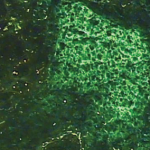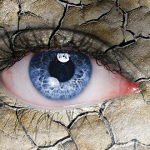This interaction of different central pathways has been postulated by neuroscientists such as Dr. Ramachandran and colleagues at the University of California at San Diego’s Salk Institute to explain the phantom pain felt in an amputated extremity. His hypothesis is complex, but is nicely summarized at Ted.com/talks and in a YouTube video presentation.
Thus, we can make some immediate suggestions to help get on track to treat the benign symptoms by identifying target molecules:
- Use animal models of SS and their normal congenics (such as nonobese diabetic or thrombospondin, knockout mice) in preclinical studies to screen molecules with antiinflammatory, antidepressant, and antinociceptive agents. I predict that the “immune” animal will have a different dose response due to their inflammatory milieu and danger-signal responses.
- Study the trigeminal nerves in SS models as well as the salivary glands. Examine neurotransmitters at each site to identify new drug-target molecules.
- Investigate the corneal surface and lacrimal function in preclinical models of pain and depression, as these may be abnormal and provide new therapeutic targets.
- Involve neurochemists in the design of clinical therapies for SS.
We began our discussion of SS with the observation that local inflammation in the glands leads to a global dysfunction in secretory ability disproportionate to the number of residual acini and ductal cells. Perhaps this is an important starting point to understand the interface between inflammatory and neural/secretory pathways.
In order to make a significant difference in the quality of life for patients with SS, new therapies must not only improve extraglandular manifestations of SS, but also alleviate the symptoms (fatigue, dryness, and pain) that lead to patient disability.
We must first learn to measure the objective variables that reflect the patient’s symptoms. This will require better cooperation between rheumatologists and experts in the field of neural pain circuits. With a more focused effort, the complex interplay among immune, neural, and hypothalamic pathways in SS may finally be unraveled.
Acknowledgment
The authors gratefully acknowledge helpful discussions with Drs. Perry Rosenthal of Harvard Medical School, Boston, Mass.; Simon Bowman of University Hospitals Birmingham NHS Trust, Birmingham, England; Jules Birnbaum of the Jerome L. Greene Sjögren’s Syndrome Center, Baltimore, Md.; James Cahill of Scripps Memorial Hospital–Ximed, La Jolla, Calif.; and Vilayanur Ramachandran of the University of California at San Diego’s Salk Institute.
Dr. Fox is a rheumatologist and Carla Fox is a registered nurse in the rheumatology clinic at Scripps Memorial Hospital–Ximed in La Jolla, Calif.
References
- Bowman SJ, Booth DA, Platts RG. Measurement of fatigue and discomfort in primary Sjögren’s syndrome using a new questionnaire tool. Rheumatology (Oxford). 2004;43:758-764.
- Bowman SJ, St. Pierre Y, Sutcliffe N, et al. Estimating indirect costs in primary Sjögren’s syndrome. J Rheumatol. 2010; 37:1010-1015.
- Milligan ED, Twining C, Chacur M, et al. Spinal glia and proinflammatory cytokines mediate mirror-image neuropathic pain in rats. J Neurosci. 2003;23:1026-1040.
- Konttinen YT, Hukkanen M, Kemppinen P, et al. Peptide-containing nerves in labial salivary glands in Sjögren’s syndrome. Arthritis Rheum.1992;35:815-820.
- Rosenthal P, Borsook D. The corneal pain system. Part I: The missing piece of the dry eye puzzle. Ocul Surf. 2012;10:2-14.
- Gold R, Kappos L, Arnold DL, et al. Placebo-controlled phase 3 study of oral BG-12 for relapsing multiple sclerosis. N Engl J Med. 2012;367:1098-1107.
- Fox RI. Sjögren’s syndrome. Lancet. 2005;366:321-331.
- Ramos-Casals M, Brito-Zerón P, Sisó-Almirall A, Bosch X, Tzioufas AG. Topical and systemic medications for the treatment of primary Sjögren’s syndrome. Nat Rev Rheumatol. 2012;8:399-411.
- Theander E, Vasaitis L, Baecklund E, et al. Lymphoid organisation in labial salivary gland biopsies is a possible predictor for the development of malignant lymphoma in primary Sjögren’s syndrome. Ann Rheum Dis. 2011;70:1363-1368.
- Reksten TR, Jonsson MV, Szyszko EA, Brun JG, Jonsson R, Brokstad KA. Cytokine and autoantibody profiling related to histopathological features in primary Sjögren’s syndrome. Rheumatology (Oxford). 2009;48:1102-1106.
- Stern M, Beuerman R, Fox R, Gao J, Mircheff A, Pflugfelder S. The pathology of dry eye: The interaction between the ocular surface and lacrimal glands. Cornea. 1998;17:584-589.
- Stern M, Gao J, Siemasko K, Beuerman R, Pflugfelder S. The role of the lacrimal functional unit in the pathophysiology of dry eye. Exp Eye Res. 2004;78:409-416.
- Stern M, Schaumburg C, Dana R, Calonge M, Niederkorn J, Pflugfelder S. Autoimmunity at the ocular surface: Pathogenesis and regulation. Mucosal Immunol. 2010;3:425-442.
- Stern ME, Beuerman RW, Fox RI, Gao J, Mircheff AK, Pflugfelder SC. A unified theory of the role of the ocular surface in dry eye. Adv Exp Med Biol. 1998;438:643-651.
- Moulton EA, Becerra L, Rosenthal P, Borsook D. An approach to localizing corneal pain representation in human primary somatosensory cortex. PloS One. 2012;7:e44643.
- Omori S, Isose S, Otsuru N, et al. Somatotopic representation of pain in the primary somatosensory cortex (S1) in humans. Clin Neurophysiol. 2013;124:1422-1430.
- Matzinger P. Tolerance, danger, and the extended family. Annu Rev Immunol. 1994;12:991-1045.


